





Flower frogs can form the base for simple, Japanese-style Ikeban (or Ichiban) arrangements. These useful
Flower frogs can form the base for simple, Japanese-style Ikeban (or Ichiban) arrangements. These useful little gizmos allow you to place even a single flower stem in a vase or bowl, in exactly the position you find most pleasing. You can also put them to work holding together exuberant displays that look like you lifted a favorite corner of your flower garden and brought it inside.Use flower frogs to anchor arrangements in open, shallow dishes that you wouldn't ordinarily consider using for bouquets. 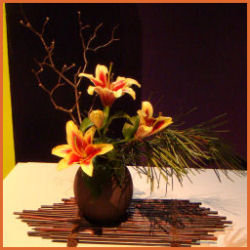 The heaviness of the frog's lead base balances the weight of the flowers and keeps them from falling over. The sturdy metal pins of the frogs can be used to secure heavier stems such as sunflowers or branches of flowering shrubs.
The heaviness of the frog's lead base balances the weight of the flowers and keeps them from falling over. The sturdy metal pins of the frogs can be used to secure heavier stems such as sunflowers or branches of flowering shrubs.
In Ikebana, the goal is often to have a natural, almost careless look to the arrangement, yet to achieve a proportion and effect that is perfectly pleasing to the eye. Nothing should be centered or exactly symmetrical in an Ikebana-inspired arrangement. The placement of every element-including empty space--should be carefully considered. Flower frogs (called kenzan) can allow very precise placement of blooms and foliage in an arrangement.
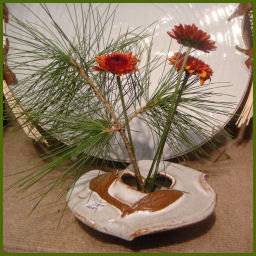 Trying to create an idealized version of the outdoors for indoor display is an art form that can take a lifetime to perfect. A number of distinct styles of Ikebana have emerged over the centuries, each with its own rules for form and composition. You don't have to be a purist to take inspiration from Ikebana, however. By using a handful of plant material, a complimentary container, and a flower frog, you can create an arrangement you'll love.
Trying to create an idealized version of the outdoors for indoor display is an art form that can take a lifetime to perfect. A number of distinct styles of Ikebana have emerged over the centuries, each with its own rules for form and composition. You don't have to be a purist to take inspiration from Ikebana, however. By using a handful of plant material, a complimentary container, and a flower frog, you can create an arrangement you'll love.
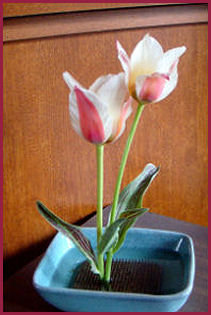 Keep it simple. When you're first starting to work with flowers in "artistic" arrangements, it's easy to add too much. Here's a helpful hint that's hard to follow when you have an abundance of pretty blooms to use. Put together an arrangement that you really like. Then take out half of everything you used, and create a simpler arrangement from what remains. I've started by spearing a single stem onto the frog, looked at the result, and just stopped right there.
Keep it simple. When you're first starting to work with flowers in "artistic" arrangements, it's easy to add too much. Here's a helpful hint that's hard to follow when you have an abundance of pretty blooms to use. Put together an arrangement that you really like. Then take out half of everything you used, and create a simpler arrangement from what remains. I've started by spearing a single stem onto the frog, looked at the result, and just stopped right there. 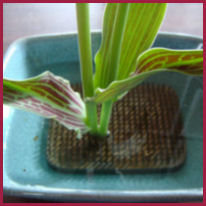 Sometimes, less really is more.
Sometimes, less really is more.
Create movement. Don't strive for a symmetrical arrangement, with the tallest or largest element perfectly centered. Instead, allow one side of the arrangement to be weighted by a large or colorful bloom, and leave some empty space on the other side to balance it out. Then tie the arrangement of flower and empty space into a more harmonious whole by using an additional element such as a curving leaf or branch. 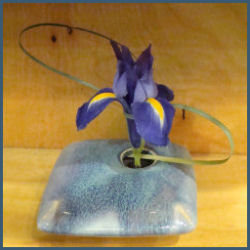 Your eye will be drawn out and away from the "main attraction" flower, providing visual flow.
Your eye will be drawn out and away from the "main attraction" flower, providing visual flow.
Search high and low for drama. Using a flower frog in a shallow container allows you to use material of different heights for a dynamic display. Arrangements can be low and spreading, tall and spiky, or both. 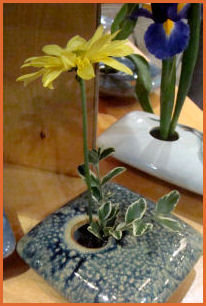 You don't always need a medium-height element, as that mid-height can be your empty space. A short, bold bloom can provide an anchor, balancing out a tall element on the other side of the dish.
You don't always need a medium-height element, as that mid-height can be your empty space. A short, bold bloom can provide an anchor, balancing out a tall element on the other side of the dish.
Re-create what you love. If you like the look of wispy Russian sage towering over stout foxglove blooms or bold ruffled poppies, incorporate those things in your arrangement. In Ikebana, elements are used to suggest much larger realities. Use a single sprig of sage to represent that towering bush, and use two poppy blooms--one taller, to show off against the sage, and one very short, to represent an endless field of flowers.
Remember how they grew. Use the flower frog to support a natural-looking clump of daffodil or crocus blooms and foliage. Create combinations in the container that you wish you'd thought to plant together in your garden. 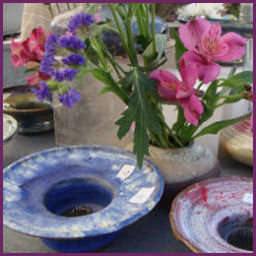 Nature isn't about perfection, so including a bent leaf or bug-bitten bud lends a note of reality to your arrangement.
Nature isn't about perfection, so including a bent leaf or bug-bitten bud lends a note of reality to your arrangement.
Although I loved the cleverness of containers with built-in frogs, I didn't go home with one that day at the fair. I have any number of dishes and bowls I can press into service, and I have a collection of frogs in different sizes and shapes to fit them. 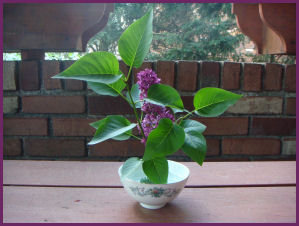 A dab of museum putty helps anchor the frog in the container if I'm working with a lot of heavy material. But I'll keep my eyes open at the next festival, in case there's a container I just can't resist.
A dab of museum putty helps anchor the frog in the container if I'm working with a lot of heavy material. But I'll keep my eyes open at the next festival, in case there's a container I just can't resist.
I hope you'll search out a flower frog, and dig a favorite dish out of the bottom of your china cabinet to use with it. Use the suggestions above to bring a bit of your garden inside. I just love my spiky, funny little frogs, and I'll bet you will too!
Move your mouse over images and links for additional information.
Photos by Jill M. Nicolaus. Images of vendor items used with permission; see below for contact information.
For more about frogs, see "A Brief History of Flower Frogs."
Cream pottery with sage leaf imprints by Functional Ceramics in Onio, seen at a 2008 fall Sugarloaf Craft Show. Contact: [email protected]
Colorful glazed pottery bowls by Groundhog Blues. seen at a 2008 spring Sugarloaf Craft Festival. Contact: Helen & Allen at [email protected]
Elegant square vases by Georgetown Pottery, seen at the 2009 Philadelphia Flower Show. Click link for information.
(Editor's Note: This article was originally published on March 19, 2009. Your comments are welcome, but please be aware that authors of previously published articles may not be able to respond to your questions.)
Copyright © www.100flowers.win Botanic Garden All Rights Reserved